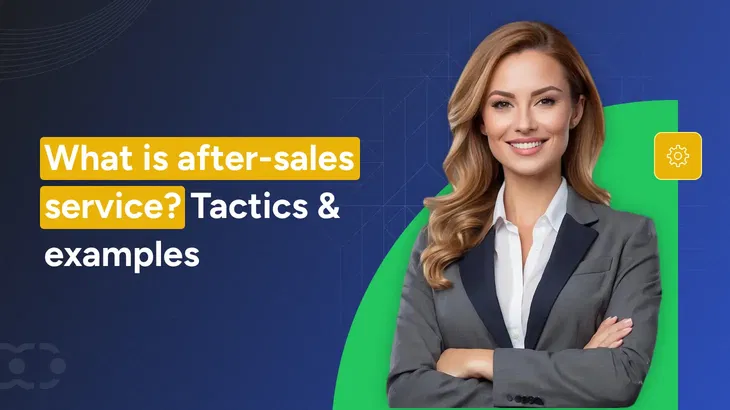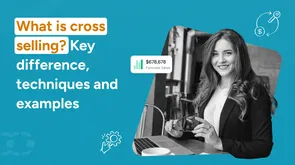The sale closes the deal. But it's what happens next that builds the business.
Most companies obsess over lead generation. But growth doesn't come from adding more; it comes from keeping more.
92% of customers are more likely to make a repeat purchase after a positive post-purchase experience. Yet too many brands treat customers like transactions, not relationships.
That's where they lose.
And to be precise, we are not just talking about sending a thank-you email after the sale. It's about designing an after-sales journey that builds trust, deepens loyalty, and maximizes lifetime value to scale that experience across every touchpoint.
In this guide, we'll show you how to do post-sale service for a competitive edge. If your goal is long-term revenue, not short-term wins, this is where the real strategy begins.
What is after-sales service?
After-sales service is the system of support and engagement that drives loyalty, retention, and repeat revenue following the purchase.
After-sales service isn't just a checkbox. It needs to be intentional, automated, and tied to the customer lifecycle.
For example, after-sales service in real estate includes post-sale documentation, handover assistance, legal support, and maintenance, the kind of care that earns trust and referrals.
While the specifics vary from industry to industry, the goal remains the same: to strengthen customer relationships, boost satisfaction, and drive long-term loyalty through consistent post-purchase engagement.
Unlike traditional after-sales service support, which reacts to problems, modern strategies proactively guide and retain customers throughout the entire journey.
After-sales service includes everything from onboarding and support to loyalty rewards and feedback collection.
Core components of after-sales service:
- Onboarding: Help customers get value fast with guided setup and education.
- Support: Provide timely help for product issues or usage challenges.
- Loyalty: Reward repeat purchases, referrals, and ongoing engagement.
- Feedback: Gather insights through reviews, surveys, and direct input to improve future experiences.
Unlike traditional after-sales support, which reacts to problems, modern strategies proactively guide and retain customers throughout the entire journey. Service after sales is designed to guide, educate, and delight customers across every post-purchase touchpoint.
The most effective brands in 2026 offer a range of after-sales service offerings tailored to their customer segments.
Here are eight proven types of after-sales service:
- Technical support: Live chat, help desk, and on-call assistance for troubleshooting or product questions
- Warranty & repair services: Hassle-free replacements, extended warranties, and fast repairs
- Customer onboarding & training: Tutorials, webinars, walkthroughs, and personalized setup flows
- Returns & exchanges: Simple return processes, automated workflows, and transparent policies
- Customer loyalty programs: Points, referrals, VIP offers, and reward tiers to boost engagement and drive retention
- Self-service tools: Knowledge bases, FAQ libraries, video content, and other support resources to enable faster resolutions
- Proactive outreach: Usage-based nudges, birthday messages, or check-ins after milestones
- Customer feedback collection: NPS surveys, review requests, and product feedback loops to gather valuable feedback that shapes future improvements.
Why is after-sales service important for businesses?
The importance of after-sales service will be evident in many ways, whether it involves building loyalty and long-term revenue.
Here are the top advantages of after-sales service that high-performing teams are leveraging in 2026:
1. Retention fuels sustainable growth
It's more cost-effective to retain customers than to acquire new ones.
A study found existing customers are 60–70% more likely to make a purchase again, compared to just 5–20% for new customers.
A well-executed post-sale strategy plays a crucial role in increasing customer retention rates year over year. That's why high-growth companies focus just as much on what happens after the sale as they do on what happens before it.
An intentional post-sale journey helps build trust and create repeat customers who continue to come back and refer others.
2. Loyal customers spend more and stick longer
Customers who feel cared for come back, not just because they need your product, but because they trust your brand.
Over time, they spend more, engage more, and bring others with them. These satisfied customers become your most valuable advocates, driving organic growth through word-of-mouth.
That's a compounding engine that fuels brand loyalty and long-term revenue, something most businesses underestimate.
These long-term relationships lead to more referrals, stronger retention, and consistent repeat business. Their positive experiences make them more likely to return and make future purchases.
3. It prevents churn before it starts
Poor onboarding. Delayed support. A lack of follow-up. These aren't minor oversights; they're silent churn drivers.
After-sales service addresses this by providing simple yet consistent experiences. Proactive check-ins, educational resources, and thoughtful support that demonstrates you haven't disappeared after the transaction.
4. It meets the emotional bar that customers expect
Today's customers don't just want responsive service; they expect brands to remember them, personalize communication, and follow through.
Done right, after-sales care ensures customers feel valued, heard, and supported beyond the purchase. And loyalty always follows value.
Seven best practices for modern after-sales service management
A well-designed after-sales strategy powered by your CRM (Customer Relationship Management) can turn post-purchase moments into lasting customer loyalty.
Below are seven practical tactics used by leading customer-centric brands.
1. Automate lifecycle outreach
The first 60 days post-purchase shape your customer's perception of your brand.
Use your CRM to trigger personalized messages at key milestones, like day 1, 7, 30, and 60.
- Send a thank-you email right after the purchase and continue engaging customers with personalized follow-ups using an email marketing CRM.
- Follow up with helpful tips, feature reminders, or usage check-ins to ensure ongoing support.
- Send re-engagement emails to customers who haven't activated a feature.
These touchpoints demonstrate to customers that you care and prevent silent churn before it occurs.
Explore: 12 Types of sales emails to increase customer engagement.
2. Support across every channel
Customers expect fast and consistent help, whether they contact you via chat, phone, or email.
With a connected CRM, your support team can:
- See past interactions instantly
- Provide context-aware answers
- Maintain a seamless experience across all channels
A consistent after-sales customer service experience ensures customers never feel lost, regardless of the channel they choose.
3. Remove friction from returns
Returns are a loyalty test. If they're slow or complicated, trust erodes fast.
Here's how to fix it:
- Publish clear, no-hassle return policies
- Use CRM automation to handle requests, updates, and refunds
- Let customers track everything without chasing your team
Fast, frictionless returns not only retain customers but also earn referrals.
4. Reward loyalty in real time
Don't wait for renewal season to say "thanks." Use your CRM to trigger real-time rewards.
Examples:
- Celebrate a customer's 1-year mark with a surprise discount
- Send exclusive perks after their 10th purchase
- Automate referral rewards when they bring others in
Timely recognition reinforces loyalty and makes your brand memorable.
5. Educate customers at the right moment
Confused customers churn. Educated customers stick around.
Use behavior-based triggers to send the right content at the right time:
- Onboarding guides right after initial purchase
- Advanced tutorials based on feature usage
- Fixes or explanations when your CRM detects common support questions
Education should feel personalized, not generic. That's what drives real product adoption.
6. Create a branded post-purchase experience
The experience doesn't end at "order confirmed." It continues with delivery, unboxing, and follow-up.
Standout brands:
- Send real-time shipment updates through a CRM with text messaging to keep customers informed the moment their order moves.
- Package products in line with their brand values
- Include personalized messages or QR codes linking to bonus content
These micro-moments create emotional resonance and build a positive brand image, turning customers into brand advocates.
7. Build a customer-powered community
People trust people more than marketing. A customer-led community can multiply retention.
Whether it's a user group, a private Slack channel, or monthly webinars:
- Let customers connect, share tips, and troubleshoot together
- Encourage user-generated content and feedback
- Gather insights directly from your power users
Communities naturally create connections, reduce support loads, and boost engagement.
Struggling with slow, inconsistent support?
Free your agents from repetitive tasks and speed up resolution with AI-powered assistance that works.
How to build your after-sales service strategy
Providing after-sales service that is consistent, automated, and data-driven is the new competitive advantage.
Here's how to build an after-sales strategy that scales:
1. Visualize the post-sale journey
Start by mapping every touchpoint in the customer journey after the sale, from confirmation to renewals.
Then ask:
- Where are the gaps?
- Are customers going dark after onboarding?
- Are repeat buyers falling off before renewal?
Utilize your CRM to identify areas of drop-off, missed follow-ups, or friction points. Once you see the full picture, you can fix what's broken and double down on what works.
2. Segment for precision
Not all customers need the same level of support. Tailor your approach using real-time CRM segmentation based on:
- Purchase history
- Engagement levels
- Customer tier or lifecycle stage
Examples:
- High-value accounts get VIP support or a dedicated manager
- First-time buyers receive a guided onboarding sequence
- Inactive users get win-back workflows
Smart segmentation = relevant experiences at scale.
3. Define and automate service standards
Set internal rules for service delivery, then use workflow automation to handle follow-ups, route tickets based on issue type, and auto-escalate delayed responses so your team can focus on resolving, not reacting.
Define:
- SLAs for first responses and ticket resolution
- Escalation triggers
- Follow-up timelines for refunds, returns, or poor NPS scores
Automate the entire workflow in your after-sales service CRM or help desk. Example: If an NPS drops below 6, trigger a callback task for your success team and send a feedback survey.
Consistency is your secret weapon, and automation makes it repeatable.
4. Build the right tech stack
A great after-sales strategy is only as strong as your tools and how they talk to each other.
That's where after-sales service management software becomes essential, as it connects your CRM, helpdesk, and support workflows into one unified platform.
At a minimum, your stack should include:
- CRM (e.g., Salesmate, HubSpot) for customer data, workflows, and personalization
- Helpdesk (e.g., Zendesk, Salesmate) for multi-channel support
- Feedback tools (e.g., Typeform, Delighted) for CSAT and NPS
- Self-service (e.g., Intercom, Document360) for knowledge bases and user guides
Integrate them so that your team has a single source of truth, and your customer experience remains seamless.
If you're looking for a unified solution that streamlines both sales and support, a modern after-sales service software goes far beyond basic help desk tools.
It centralizes customer interactions, automates ticket resolution, delivers proactive communication, and enforces SLAs, all within a single system.
For example, Salesmate combines CRM, ticketing software, and automation capabilities into one platform, helping support teams stay ahead of issues and build loyalty at scale.
Explore: 17 Best help desk software to try in 2026.
5. Empower your support teams
Automation is powerful, but your people still make the difference.
Equip your team with full visibility into customer history, usage, and feedback to deliver great customer service every time.
Furthermore, leverage CRM insights and an integrated ticketing system to personalize every response and efficiently track issue resolution.
Your support playbooks should also be equipped to resolve customer complaints quickly and empathetically, thereby preventing churn.
Review KPIs monthly, such as resolution time and customer satisfaction scores, and refine your approach accordingly.
Most importantly: close the loop. When feedback reveals a problem, address it and let the customer know you've listened.
Build a smarter post-sale experience
Automate touchpoints, trigger loyalty workflows, and personalize every follow-up with CRM-powered automation.
Future trends in after-sales service
As customer expectations shift and technology evolves, brands that adapt now will lead tomorrow.
Here are three trends redefining the future of post-purchase care and how you can prepare for them.
1. AI-powered support and predictive automation
AI is transforming how support is delivered, not just faster, but smarter.
Forward-thinking companies use AI to:
- Personalize responses using real-time CRM data
- Automate common tasks while keeping the service human
- Flag issues like low usage or failed logins before the customer reaches out
This predictive approach reduces churn rate and strengthens trust by resolving issues before they arise.
2. Sustainability and repair-first service
Today's customers care about how you operate, not just what you offer.
That's why service strategies are shifting toward:
- Repair-first policies and refurbished product options
- Digital manuals and paperless returns
- Low-waste packaging and eco-friendly return kits
Sustainable support isn't a gimmick; it signifies a long-term commitment and fosters stronger emotional loyalty.
3. Community-led support
Support isn't just a one-way street anymore.
Smart brands cultivate communities, such as user forums, Slack groups, and webinars, where customers connect, share, and collaborate to solve problems together.
This not only lightens the support load but also:
- Deepens engagement
- Surfaces product feedback organically
- Turns users into advocates who help retain others
Your best support channel might already be your most loyal customers.
Must know: How to scale your support with AI-powered automation.
Conclusion
In 2026, delivering good after-sales service is no longer optional; it's a strategic asset for customer retention and loyalty.
- Every post-sale touchpoint drives loyalty and lifetime value
- Satisfied customers drive referrals, reviews, and long-term growth
- Your CRM should power automation, personalization, and smarter service
Want long-term growth? Treat post-sale interactions with the same intent as pre-sale interactions.
Effective after-sales service creates meaningful touchpoints that drive trust, advocacy, and long-term growth.
Start by using your Salesmate to automate follow-ups, personalize outreach, and scale retention.
Frequently asked questions
1. How is after-sales service different from pre-sale support?
Pre-sale support helps potential customers make informed decisions, answering questions and addressing their objections. After-sales service kicks in post-purchase, focusing on onboarding, support, and retention. It's where long-term loyalty is built.
2. How can CRM improve post-sale engagement?
A CRM centralizes customer data and powers automation. It helps teams:
-
Trigger follow-ups and check-ins
-
Personalize communication
-
Launch loyalty or support workflows based on real-time behavior
3. What is an after-sales service contract?
It's a formal agreement that defines post-sale support terms, including warranty coverage, service timelines, and escalation processes. Common in B2B, electronics, and high-ticket sales, it sets clear expectations for both sides.
4. Is after-sales service a legal requirement?
Not always. However, warranties, return rights, and consumer protections are often regulated by law, particularly in the retail and electronics sectors.
Beyond compliance, strong after-sales service is a key driver of retention and word-of-mouth.
5. What is the post-sales process?
The post-sales or after-sales service process includes every customer interaction after purchase, onboarding, delivery, support, feedback collection, loyalty rewards, and renewals.
6. What does an after-sales manager do?
After sales managers own the post-purchase experience, they lead support teams, manage returns or SLAs, improve retention programs, and track KPIs such as CSAT and NPS.
Their goal is to keep customers engaged long after the sale has been made.
7. What are some after-sales service examples in SaaS or eCommerce?
Here are some examples of after-sales service:
-
SaaS: Onboarding emails, product tutorials, usage-based nudges, renewal reminders, and NPS surveys
-
eCommerce: Thank-you messages, loyalty discounts, return automation, and follow-up support
8. What does automotive after-sales service include?
Automotive after-sales service includes scheduled maintenance, warranty repairs, customer support, spare parts management, and feedback collection. Leading car manufacturers now use CRM-powered tools to automate follow-ups, track vehicle history, and personalize service reminders, turning buyers into loyal service customers.







Key takeaway
After-sales service boosts loyalty, reduces churn, and increases long-term revenue.
Great post-sale experiences include onboarding, support, education, rewards, and feedback through CRM automation.
Buyers expect fast, personalized, and exceptional customer service, whether they contact you via chat, phone, or email.
Loyalty at scale needs segmentation, automation, and a CRM that drives consistent follow-up.
The sale closes the deal. But it's what happens next that builds the business.
Most companies obsess over lead generation. But growth doesn't come from adding more; it comes from keeping more.
92% of customers are more likely to make a repeat purchase after a positive post-purchase experience. Yet too many brands treat customers like transactions, not relationships.
That's where they lose.
And to be precise, we are not just talking about sending a thank-you email after the sale. It's about designing an after-sales journey that builds trust, deepens loyalty, and maximizes lifetime value to scale that experience across every touchpoint.
In this guide, we'll show you how to do post-sale service for a competitive edge. If your goal is long-term revenue, not short-term wins, this is where the real strategy begins.
What is after-sales service?
After-sales service is the system of support and engagement that drives loyalty, retention, and repeat revenue following the purchase.
After-sales service isn't just a checkbox. It needs to be intentional, automated, and tied to the customer lifecycle.
For example, after-sales service in real estate includes post-sale documentation, handover assistance, legal support, and maintenance, the kind of care that earns trust and referrals.
While the specifics vary from industry to industry, the goal remains the same: to strengthen customer relationships, boost satisfaction, and drive long-term loyalty through consistent post-purchase engagement.
Unlike traditional after-sales service support, which reacts to problems, modern strategies proactively guide and retain customers throughout the entire journey.
After-sales service includes everything from onboarding and support to loyalty rewards and feedback collection.
Core components of after-sales service:
Unlike traditional after-sales support, which reacts to problems, modern strategies proactively guide and retain customers throughout the entire journey. Service after sales is designed to guide, educate, and delight customers across every post-purchase touchpoint.
The most effective brands in 2026 offer a range of after-sales service offerings tailored to their customer segments.
Here are eight proven types of after-sales service:
Why is after-sales service important for businesses?
The importance of after-sales service will be evident in many ways, whether it involves building loyalty and long-term revenue.
Here are the top advantages of after-sales service that high-performing teams are leveraging in 2026:
1. Retention fuels sustainable growth
It's more cost-effective to retain customers than to acquire new ones.
A study found existing customers are 60–70% more likely to make a purchase again, compared to just 5–20% for new customers.
A well-executed post-sale strategy plays a crucial role in increasing customer retention rates year over year. That's why high-growth companies focus just as much on what happens after the sale as they do on what happens before it.
An intentional post-sale journey helps build trust and create repeat customers who continue to come back and refer others.
2. Loyal customers spend more and stick longer
Customers who feel cared for come back, not just because they need your product, but because they trust your brand.
Over time, they spend more, engage more, and bring others with them. These satisfied customers become your most valuable advocates, driving organic growth through word-of-mouth.
That's a compounding engine that fuels brand loyalty and long-term revenue, something most businesses underestimate.
These long-term relationships lead to more referrals, stronger retention, and consistent repeat business. Their positive experiences make them more likely to return and make future purchases.
3. It prevents churn before it starts
Poor onboarding. Delayed support. A lack of follow-up. These aren't minor oversights; they're silent churn drivers.
After-sales service addresses this by providing simple yet consistent experiences. Proactive check-ins, educational resources, and thoughtful support that demonstrates you haven't disappeared after the transaction.
4. It meets the emotional bar that customers expect
Today's customers don't just want responsive service; they expect brands to remember them, personalize communication, and follow through.
Done right, after-sales care ensures customers feel valued, heard, and supported beyond the purchase. And loyalty always follows value.
Seven best practices for modern after-sales service management
A well-designed after-sales strategy powered by your CRM (Customer Relationship Management) can turn post-purchase moments into lasting customer loyalty.
Below are seven practical tactics used by leading customer-centric brands.
1. Automate lifecycle outreach
The first 60 days post-purchase shape your customer's perception of your brand.
Use your CRM to trigger personalized messages at key milestones, like day 1, 7, 30, and 60.
These touchpoints demonstrate to customers that you care and prevent silent churn before it occurs.
2. Support across every channel
Customers expect fast and consistent help, whether they contact you via chat, phone, or email.
With a connected CRM, your support team can:
A consistent after-sales customer service experience ensures customers never feel lost, regardless of the channel they choose.
3. Remove friction from returns
Returns are a loyalty test. If they're slow or complicated, trust erodes fast.
Here's how to fix it:
Fast, frictionless returns not only retain customers but also earn referrals.
4. Reward loyalty in real time
Don't wait for renewal season to say "thanks." Use your CRM to trigger real-time rewards.
Examples:
Timely recognition reinforces loyalty and makes your brand memorable.
5. Educate customers at the right moment
Confused customers churn. Educated customers stick around.
Use behavior-based triggers to send the right content at the right time:
Education should feel personalized, not generic. That's what drives real product adoption.
6. Create a branded post-purchase experience
The experience doesn't end at "order confirmed." It continues with delivery, unboxing, and follow-up.
Standout brands:
These micro-moments create emotional resonance and build a positive brand image, turning customers into brand advocates.
7. Build a customer-powered community
People trust people more than marketing. A customer-led community can multiply retention.
Whether it's a user group, a private Slack channel, or monthly webinars:
Communities naturally create connections, reduce support loads, and boost engagement.
Struggling with slow, inconsistent support?
Free your agents from repetitive tasks and speed up resolution with AI-powered assistance that works.
How to build your after-sales service strategy
Providing after-sales service that is consistent, automated, and data-driven is the new competitive advantage.
Here's how to build an after-sales strategy that scales:
1. Visualize the post-sale journey
Start by mapping every touchpoint in the customer journey after the sale, from confirmation to renewals.
Then ask:
Utilize your CRM to identify areas of drop-off, missed follow-ups, or friction points. Once you see the full picture, you can fix what's broken and double down on what works.
2. Segment for precision
Not all customers need the same level of support. Tailor your approach using real-time CRM segmentation based on:
Examples:
Smart segmentation = relevant experiences at scale.
3. Define and automate service standards
Set internal rules for service delivery, then use workflow automation to handle follow-ups, route tickets based on issue type, and auto-escalate delayed responses so your team can focus on resolving, not reacting.
Define:
Automate the entire workflow in your after-sales service CRM or help desk. Example: If an NPS drops below 6, trigger a callback task for your success team and send a feedback survey.
Consistency is your secret weapon, and automation makes it repeatable.
4. Build the right tech stack
A great after-sales strategy is only as strong as your tools and how they talk to each other.
That's where after-sales service management software becomes essential, as it connects your CRM, helpdesk, and support workflows into one unified platform.
At a minimum, your stack should include:
Integrate them so that your team has a single source of truth, and your customer experience remains seamless.
If you're looking for a unified solution that streamlines both sales and support, a modern after-sales service software goes far beyond basic help desk tools.
It centralizes customer interactions, automates ticket resolution, delivers proactive communication, and enforces SLAs, all within a single system.
For example, Salesmate combines CRM, ticketing software, and automation capabilities into one platform, helping support teams stay ahead of issues and build loyalty at scale.
5. Empower your support teams
Automation is powerful, but your people still make the difference.
Equip your team with full visibility into customer history, usage, and feedback to deliver great customer service every time.
Furthermore, leverage CRM insights and an integrated ticketing system to personalize every response and efficiently track issue resolution.
Your support playbooks should also be equipped to resolve customer complaints quickly and empathetically, thereby preventing churn.
Review KPIs monthly, such as resolution time and customer satisfaction scores, and refine your approach accordingly.
Most importantly: close the loop. When feedback reveals a problem, address it and let the customer know you've listened.
Build a smarter post-sale experience
Automate touchpoints, trigger loyalty workflows, and personalize every follow-up with CRM-powered automation.
Future trends in after-sales service
As customer expectations shift and technology evolves, brands that adapt now will lead tomorrow.
Here are three trends redefining the future of post-purchase care and how you can prepare for them.
1. AI-powered support and predictive automation
AI is transforming how support is delivered, not just faster, but smarter.
Forward-thinking companies use AI to:
This predictive approach reduces churn rate and strengthens trust by resolving issues before they arise.
2. Sustainability and repair-first service
Today's customers care about how you operate, not just what you offer.
That's why service strategies are shifting toward:
Sustainable support isn't a gimmick; it signifies a long-term commitment and fosters stronger emotional loyalty.
3. Community-led support
Support isn't just a one-way street anymore.
Smart brands cultivate communities, such as user forums, Slack groups, and webinars, where customers connect, share, and collaborate to solve problems together.
This not only lightens the support load but also:
Your best support channel might already be your most loyal customers.
Conclusion
In 2026, delivering good after-sales service is no longer optional; it's a strategic asset for customer retention and loyalty.
Want long-term growth? Treat post-sale interactions with the same intent as pre-sale interactions.
Effective after-sales service creates meaningful touchpoints that drive trust, advocacy, and long-term growth.
Start by using your Salesmate to automate follow-ups, personalize outreach, and scale retention.
Frequently asked questions
1. How is after-sales service different from pre-sale support?
Pre-sale support helps potential customers make informed decisions, answering questions and addressing their objections. After-sales service kicks in post-purchase, focusing on onboarding, support, and retention. It's where long-term loyalty is built.
2. How can CRM improve post-sale engagement?
A CRM centralizes customer data and powers automation. It helps teams:
Trigger follow-ups and check-ins
Personalize communication
Launch loyalty or support workflows based on real-time behavior
3. What is an after-sales service contract?
It's a formal agreement that defines post-sale support terms, including warranty coverage, service timelines, and escalation processes. Common in B2B, electronics, and high-ticket sales, it sets clear expectations for both sides.
4. Is after-sales service a legal requirement?
Not always. However, warranties, return rights, and consumer protections are often regulated by law, particularly in the retail and electronics sectors.
Beyond compliance, strong after-sales service is a key driver of retention and word-of-mouth.
5. What is the post-sales process?
The post-sales or after-sales service process includes every customer interaction after purchase, onboarding, delivery, support, feedback collection, loyalty rewards, and renewals.
6. What does an after-sales manager do?
After sales managers own the post-purchase experience, they lead support teams, manage returns or SLAs, improve retention programs, and track KPIs such as CSAT and NPS.
Their goal is to keep customers engaged long after the sale has been made.
7. What are some after-sales service examples in SaaS or eCommerce?
Here are some examples of after-sales service:
SaaS: Onboarding emails, product tutorials, usage-based nudges, renewal reminders, and NPS surveys
eCommerce: Thank-you messages, loyalty discounts, return automation, and follow-up support
8. What does automotive after-sales service include?
Automotive after-sales service includes scheduled maintenance, warranty repairs, customer support, spare parts management, and feedback collection. Leading car manufacturers now use CRM-powered tools to automate follow-ups, track vehicle history, and personalize service reminders, turning buyers into loyal service customers.
Sonali Negi
Content WriterSonali is a writer born out of her utmost passion for writing. She is working with a passionate team of content creators at Salesmate. She enjoys learning about new ideas in marketing and sales. She is an optimistic girl and endeavors to bring the best out of every situation. In her free time, she loves to introspect and observe people.